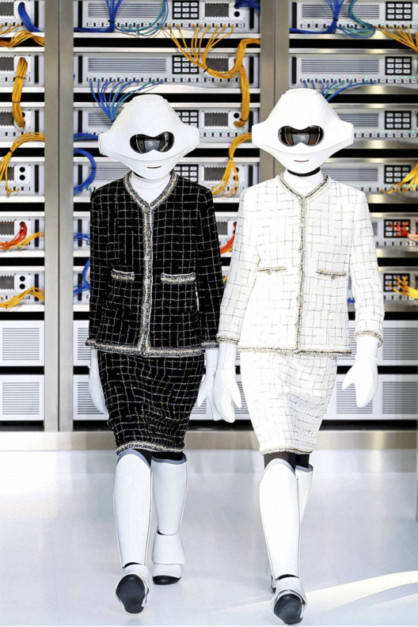
Paris: Other designers at this season’s Paris fashion week are miffed that the clothes on the catwalk have struggled for airtime, overshadowed by the drama happening in the wings.
Karl Lagerfeld, however, demonstrated how Chanel retains its position as the biggest show in Paris by turning the off-catwalk commotion into spotlighting for Chanel.
The two big stories of fashion week are the blogger backlash, a row which is a microcosm of how the digital era has disrupted fashion, and the new “model-free” issue of British Vogue, featuring “real” people.
Chanel’s theme for Tuesday’s show, staged at the Grand Palais, was the digital world — hardly lightbulb moment stuff, since it doesn’t take much insight to clock its impact on fashion, in the season of see now, buy now. But what was interesting was that Lagerfeld, who owns four iPhones and about 30 iPads — including one used by his cat, Choupette — focused not on our intimate relationship with the friendly screens in our pockets, but on the slightly sinister, unknowable might of data centres and server racks.
And he opened the collection, pointedly, not with a supermodel with millions of Instagram followers, but with an anonymous woman in a white plastic robot mask, gloves and boots, who appeared to have based her look on a cross between a stormtrooper and Thomas Bangalter from Daft Punk.
The invitation to the show featured the brand’s double C logo made from colourful modem cables, twisted together until they frayed like the boucle wool of Chanel’s famous skirt suits, and the grand Beaux Arts interior of the Grand Palais was given a Silicon Valley makeover: all brushed steel, smooth white surfaces, snaking coils of cables and flickering screens.
The scale of the set, and the sense of computing as something alien rather than native and everyday, made the catwalk feel more retro than futuristic. The soundtrack was I Feel Love by Donna Summer, the Giorgio Moroder game changer that set music on a new path in 1977. That was six years before Lagerfeld joined Chanel, and the song still sounds relevant today, which was perhaps his point.
The retro mood was overt in the styling. Models in skewed baseball caps and side ponytails wore medallions around their necks in the style of the Beastie Boys’ Licensed to Ill era. (That the medallions could be reconfigured as modern office-pass lanyards added a layer of modern, e-surveillance paranoia.) Handbags were modelled on robots of a Star Wars vintage. But the clothes were classic Chanel: boucle tweed suits worn shoulder-robed with flat boots, and silk tea dresses slit to the hip for this season’s on-trend flying panels, in circuit board prints.
Skirt suit jackets sported square Velcro fasteners, instead of buttons, with skirts with a sexy split down the front.
“Velcro is so much easier than a button,” Lagerfeld said.
He characterized the collection designs as “intimate technology” - femininity hidden behind something high-tech.
Some styles evoked the busy textured surface of a circuit board with the ultra-vivid colors of computer circuitry. At times, it was a little too-much, as in one loose black, pink and purple double-breasted jacket on which the colors emanated out in blurred lines like overheated wires.
Elsewhere it worked, like a tight black jacket with silver solder-like markings.
— With inputs from AP














